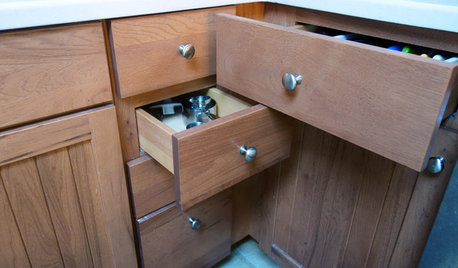Does anyone have some Artisan Mustard tips?
j_dubyak
15 years ago
Featured Answer
Sort by:Oldest
Comments (37)
ksrogers
15 years agolast modified: 9 years agozabby17
15 years agolast modified: 9 years agoRelated Discussions
Anyone have tips for growing wild or lowbush blueberries?
Comments (9)We have several lowbush varieties, along with both highbush and half-high blueberries. The lowbush have similar requirements for sun, soil pH, and moisture. The main issue is that you need to be two feet tall in order to pick the fruit without stooping. Lowbush varieties have one big advantage over the taller shrubs. They are routinely snowed under in the winter, which goes a long way to protect the shrub from browsing rabbits and deer. Also moose, if you live in Maine or Canada...I believe that the extensive lowbush blueberry beds in Maine are harvested by machine, a type of rotating horizontal brush mounted on a tractor. After harvest, the entire bed is mowed down, and allowed to lie fallow for a season, so the shrubs can recover. Then the process repeats, so there will be a harvest event every other year. It is not actually necessary to mow down your lowbush blueberry shrubs, they do fine with a little pruning now and then. In the landscape scene, they would be described as groundcover. These are pretty tough plants, better able to survive a dry spell than the highbush shrubs. If you can get the pH down to 4.5 or so, a typical shrub might produce 1/2 cup of fruit....See MoreAnyone doing Artisan Bread in 5-minutes a day?
Comments (64)I followed the link teresa posted & mixed up a batch of master recipe on Wednesday evening. I baked my first loaf of artisan bread tonight. After if came out of the oven I almost broke my arm patting myself on the back. Never ever would I have thought it would turn out so good. I preheated my oven to 500. Once it reached 500 I then turned it back to 450. I have an old oval shaped clay baker (it has seldom been used) that I put in my oven along with the lid. Set my timer for 45 minutes then proceded to prep the dough. There was no work to it at all. Just like the video I was able to cut a chunk off and shape it with a little more flour in less than a minute. I threw it on a silpat sheet sprinkled with cornmeal to rise. 45 minutes later I put a couple of slits in it then into my baker it went. I added the lid and set my timer for another 30 minutes. I didn't know if I should remove the lid half way thru or not. As a matter of fact I didn't even think about removing the lid till about 5 minutes befor the timer was to go off. I did remove it at that time and was amazed at how great the bread looked. Five minutes later I pulled it from the oven. I was telling myself to let it cool down befor I cut into it. Bread should not be cut while its hot. Right? Heck I don't know. I have no willpower!! Oh my I was in shock. I still can't believe I produced such a beautiful tasty loaf of artsian bread. Thank you teresa for the link to the recipe. Now that I have tried it and it worked I will buy the book ASAP. I can not wait to try some of the other recipes. The pecan rolls are calling my name, my very own home made english muffins and pitas! I want to make a marble rye worthy of Jerry Seinfield! I have plans to go to the Amish store for several different flours and spices. I am gonna weigh a ton! Dawn...See MoreDoes Anyone Have THIS Datura? And Have Seed For Sale/Trade?
Comments (3)The 'Box Of Chocolate' seeds I bought, have finally just germinated, over the past 4 days. So I have a few of each of the 5 different varieties of 'BOC' datura plants. 'Purple Lace', 'Purple Confusion', 'E', and 'Purple Specks', and 'Tri-Color' At least they are up and starting to grow. I STILL cant get Double Yellow datura seeds!!! I pay for them, and pay for them, and I keep getting the double purple/white ones. The last pack of seeds i bought, all of 10 seeds, for $3,...i planted them all and after 3 weeks, none came up! I uncovered them and not a root tip in sight. But my 'BOC' ones came up in about 9 days. I told the seller this, and he SAYS he sent me replacement ones,...3 weeks ago...from GA.! I have opened a case against him on EBay, and I STILL dont have the double yellow ones! Cant trust anyone on EBay to send me these double yellow ones. I give up....See MoreDoes anyone have any tips on how to compost efficiently?
Comments (9)People compost for different reasons. For example: They have scrap vegetable matter they don't want to add to a landfill. They want free soil amendments for their garden Note that the first reason focuses on the input - you want to use up excess materials, and the second reason focuses on the output - you need more compost. What works best for you depends on which side of the equation you want to prioritize. Another factor has to do with where you live. If you are in a rural area on a large property then having compost piles on the edge of the property is nothing anyone would notice. In the suburbs piles of vegetation may not be as easily hidden, and in the city you have very little space to begin with and have to factor in rats. Large bins make more sense in suburban yards and tumblers may be the only possible "rat proof" option for the city. However, I agree with Floral_UK - if your definition of "efficient" is least amount of work and most potent end product - slow cold composting is the way to go. Put a bunch of carbon-rich material (leaves, twigs, wood) in a pile or bin and let it sit for a couple of years (longer if there are chunks of wood), and you will end up with a rich, moist hummus that would benefit any type of soil. After all, this is the way Mother Nature does it and this process created all the fertile soil on Earth. If you want fast, then start with the same pile but: Chop everything into small bits Add "green" nitrogen-rich materials as well Make the pile as big as you can - bigger than 1 meter square at the smallest. The bigger it is the faster it will go. A steaming mountain of brown and green material will stay warm even in the winter. And hotter = faster. Turn the pile every couple of weeks You can get usable compost in about six months. But it will have less nutrients because much of the nitrogen has been used up in the process. That, plus the extra labor involved, is the cost of going fast and hot versus slow and cold....See Moreksrogers
15 years agolast modified: 9 years agodavid52 Zone 6
15 years agolast modified: 9 years agobusylizzy
15 years agolast modified: 9 years agoksrogers
15 years agolast modified: 9 years agoreadinglady
15 years agolast modified: 9 years agobusylizzy
15 years agolast modified: 9 years agoksrogers
15 years agolast modified: 9 years agobusylizzy
15 years agolast modified: 9 years agozabby17
15 years agolast modified: 9 years agoksrogers
15 years agolast modified: 9 years agozabby17
15 years agolast modified: 9 years agoksrogers
15 years agolast modified: 9 years agomelva02
15 years agolast modified: 9 years agoj_dubyak
15 years agolast modified: 9 years agomelva02
15 years agolast modified: 9 years agobusylizzy
15 years agolast modified: 9 years agoj_dubyak
15 years agolast modified: 9 years agoksrogers
15 years agolast modified: 9 years agobcskye
15 years agolast modified: 9 years agoksrogers
15 years agolast modified: 9 years agomelva02
15 years agolast modified: 9 years agoj_dubyak
15 years agolast modified: 9 years agoksrogers
15 years agolast modified: 9 years agoreadinglady
15 years agolast modified: 9 years agoj_dubyak
15 years agolast modified: 9 years agodesertbreeze
14 years agolast modified: 9 years agocabrita
14 years agolast modified: 9 years agoksrogers
14 years agolast modified: 9 years agocabrita
14 years agolast modified: 9 years agodesertbreeze
14 years agolast modified: 9 years agoksrogers
14 years agolast modified: 9 years agogardengrl
14 years agolast modified: 9 years agoksrogers
14 years agolast modified: 9 years agomustardfreek
13 years agolast modified: 9 years ago
Related Stories

DECORATING GUIDES7 Bedroom Styling Tricks Anyone Can Do
Short on time or money? You can spruce up your bedroom quickly and easily with these tips
Full Story
FUN HOUZZ10 Truly Irritating Things Your Partner Does in the Kitchen
Dirty dishes, food scraps in the sink — will the madness ever stop?
Full Story
BUDGET DECORATINGThe Cure for Houzz Envy: Living Room Touches Anyone Can Do
Spiff up your living room with very little effort or expense, using ideas borrowed from covetable ones
Full Story
BEDROOMSThe Cure for Houzz Envy: Master Bedroom Touches Anyone Can Do
Make your bedroom a serene dream with easy moves that won’t give your bank account nightmares
Full Story
MUDROOMSThe Cure for Houzz Envy: Mudroom Touches Anyone Can Do
Make a utilitarian mudroom snazzier and better organized with these cheap and easy ideas
Full Story
HOME OFFICESThe Cure for Houzz Envy: Home Office Touches Anyone Can Do
Borrow these modest design moves to make your workspace more inviting, organized and personal
Full Story
DECORATING GUIDESThe Cure for Houzz Envy: Guest Room Touches Anyone Can Do
Make overnight guests feel comfy and cozy with small, inexpensive niceties
Full Story
BUDGET DECORATINGThe Cure for Houzz Envy: Entryway Touches Anyone Can Do
Make a smashing first impression with just one or two affordable design moves
Full Story
DECORATING GUIDESThe Cure for Houzz Envy: Family Room Touches Anyone Can Do
Easy and cheap fixes that will help your space look more polished and be more comfortable
Full Story
DECORATING GUIDESThe Cure for Houzz Envy: Dining Room Touches Anyone Can Do
Get a decorator-style dining room on the cheap with inexpensive artwork, secondhand furniture and thoughtful accessories
Full StorySponsored
Central Ohio's Trusted Home Remodeler Specializing in Kitchens & Baths



busylizzy